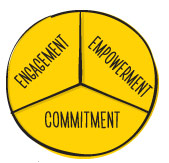 The more profound the change, the greater the effort needed to ensure long-term adoption of the changes. To foster sustained, significant enterprise-scale change, we’ve found the following general principles to be successful. Ultimately, the specific mechanisms and approach for delivering education, monitoring performance, and making corrections need to be calibrated to the organizational culture, the individual’s demeanor and job role, and the company’s measurement and communications infrastructure.
The more profound the change, the greater the effort needed to ensure long-term adoption of the changes. To foster sustained, significant enterprise-scale change, we’ve found the following general principles to be successful. Ultimately, the specific mechanisms and approach for delivering education, monitoring performance, and making corrections need to be calibrated to the organizational culture, the individual’s demeanor and job role, and the company’s measurement and communications infrastructure.
ENGAGEMENT
Buy-in is key
In order for employees to embrace and become part of the change process, they must understand and “buy-in” to the rationale for change. Employees need to believe the changes are appropriate to the job, corporate direction and culture before they will be willing to change how they think and do things.
People support what they help build
Employees are more apt to maintain changes when they are involved in developing those changes; finding ways to do that increases buy-in and advocacy for the changes.
Nurture peer support
People are more likely to support changes when their peer group provides encouragement and support. This community effect has been shown to be a major driving factor behind changing even the most deep-rooted behaviors, including: adopting a new diet, losing weight or quitting smoking.
EMPOWERMENT
Reinforce positively, coach proactively
We believe sustaining change happens through positive recognition and encouragement. Organizational change can take months, often years, of sustained focus and effort to see the desired impact. Setting short- and long-term goals and measuring progress regularly reinforces the behavior change.
Cater to individual learning modes
We know that different people have different ways they learn best. Some learn visually, such as reading a guidebook, while others learn audibly, such as listening to a podcast. And there are some who learn experientially, trying things hands-on. Catering to different learning modes maximizes the opportunity for an individual’s understanding.
Provide change support systems
Employees are more likely to maintain changes when they have easy access to the tools, templates, and continuing education to reinforce the changes made. And that also means providing enough channels to answer questions they might have, especially around the rationale for the change.
COMMITMENT
Walk the talk
Leadership must be seen supporting and living the changes. Doing so will demonstrate to the rest of the team the importance of the new changes.
Not “one and done”
Changing mindset and behavior is an experience that takes time, patience and repetition to achieve. Too often, change is treated as a singular event. The most consistently successful change efforts apply enough resources to nurture what can sometimes take months, if not years, to change.
Be consistent in rewarding desired behaviors
People tend to act in alignment with how they’re measured. Avoid confusion by being clear in the expectation and resulting measurement. .
Do you agree or disagree? What other principles have you found to work?
